Add color 🌈 and movement to your garden. Try 🌸 pink muhly grass 🌸. This beautiful grass has pink flowers that sway gently in the breeze.
When and where does Pink Muhly Grass bloom? Pink Muhly Grass blooms in late summer ☀️ and continues to bloom in the fall. It grows well in full sun and well-drained soil, making it ideal for sunny gardens.
If you are seeking to enhance the appearance of your flowerbeds, establish a privacy screen, or introduce variety to your landscape, Pink Mahli grass is an excellent option for gardeners. This plant is distinguished by its elegant demeanor and vibrant flowers.
- What is Pink Muhly Grass?
- Pink Muhly Grass Benefits
- Pink Muhly Grass and Pets
- Characteristics and Appearance of Pink Muhly Grass
- Grow Muhlenbergia capillaris in Ideal Conditions
- When Pink Muhly Grass Blooms
- Locations Where Pink Muhly Grass Thrives: What Zone is Pink Muhly Grass
- How to Plant Pink Muhly Grass
- How to Maintain Pink Muhly Grass (Caring for Pink Muhly Grass)
- How to Harvest Pink Muhly Grass Seeds
- Common Problems and Pests for Pink Muhly Grass
- Pink Muhly Grass Landscaping Ideas
- Conclusion and Final Thoughts
- Frequently Asked Questions
What is Pink Muhly Grass?
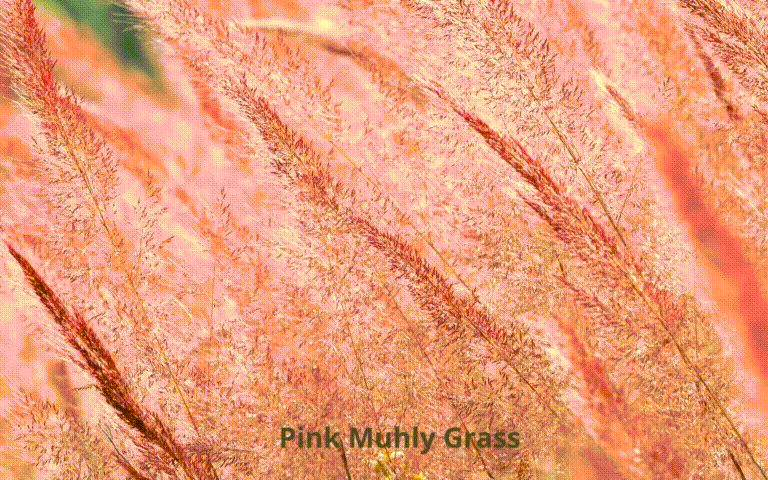
Pink Muhly Grass, known as ( Muhlenbergia capillaris ), up to 3 feet tall in clumps. It has fine, airy foliage and pink flowers. It’s drought-resistant and likes sun. It’s used in landscaping for borders, mass plantings, or as a focal point in mixed perennial beds.
This lovely plant is native to where?
It is native to the southeastern United States and is a popular choice among gardeners because it is easy to maintain and looks good.
Is it evergreen?
It is a grass that sheds its leaves in winter and grows new ones in spring. While it may lose its leaves, it often keeps its seed heads, which can look good in the garden even when it is not growing.
Is pink muhly grass a perennial?
Yes, (Muhlenbergia capillaris) is a perennial grass. This means that it lives for more than two years and persists through several growing seasons. In the case of Pink Muhly Grass, it typically regrows from its root system each year, producing new leaves and flowers.
Pink Muhly Grass Benefits
- Has beautiful pink to purple plumes that bloom in the fall.
- Low maintenance: is easy to take care of once it’s established. It can grow in different types of soil.
- Wildlife habitat: The grass provides food and shelter for wildlife. Its seeds are food for birds, while its foliage offers protection for small animals.
- Control erosion: Pink Muhly Grass has a strong root system that stops soil from eroding, making it good for slopes and other areas prone to erosion.
- Year-round interest: The grass stays green in the spring and summer, pink in the fall, and golden in the winter.
- Versatility: Pink Muhly Grass can be used in many landscaping projects. It can also be used as ground cover or in a meadow-style garden.
Pink Muhly Grass and Pets
The ASPCA (American Society for the Prevention of Cruelty to Animals) and other reputable sources don’t list grass as a toxic plant. Muhlenbergia capillaris can cause minor cuts or irritation if pets come into contact with it. Keep pets away from the grass or supervise them when they’re around it.
Is pink muhly grass toxic to cats 🐈
It’s safe for cats. Watch your cat around new plants to make sure they don’t have a bad reaction.
If your cat is itchy, sneezing, or having trouble breathing after being around the grass, take it to the vet.
Is pink muhly grass toxic to dogs 🐕
Pink Muhly Grass is not toxic to dogs, but some dogs may be allergic to it. Keep dogs away from the grass or watch them when they’re around it to avoid issues.
Is pink muhly grass toxic to horses 🐎
Pink Muhly Grass is safe for horses. They sometimes eat plants they don’t usually eat. Reactions can vary. Keep an eye on them and talk to a vet if you have concerns about plants in their environment.
Do rabbits 🐇 eat pink muhly grass
Rabbits eat pink muhly grass, but it’s not their favorite food. Rabbits eat a variety of plants, including grasses, vegetables, and fruits. Pink Muhly Grass isn’t toxic to rabbits, but it doesn’t provide them with all the nutrients they need.
Is pink muhly grass deer resistant 🦌
PMGrass has a coarse texture and sharp edges that make it less appealing to deer. However, no plant is completely deer-proof, and deer may still eat it if they are hungry or if other food sources are scarce.
If you live in an area with a lot of deer, you can take extra steps to protect your Pink Muhly Grass. This could include using deer repellents, putting up deer fencing, or planting other deer-resistant plants around your Pink Muhly Grass.
Is pink muhly grass good for pollinators 🐝
It’s good for pollinators like bees, butterflies, and other insects. The grass produces small flowers in the fall, providing nectar and pollen for pollinators.
Pink Muhly Grass is a host plant for butterflies, including the skipper butterfly. The grass is a safe place for butterflies to lay eggs and caterpillars to feed and grow.
Monitor pets around new plants and consult a vet if there are any issues.
Characteristics and Appearance of Pink Muhly Grass
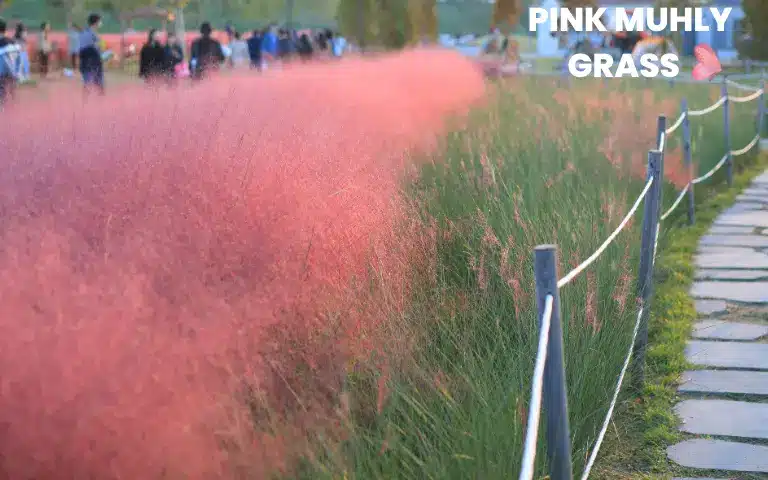
Muhlenbergia capillaris is unique and beautiful. This grass has narrow leaves in clumps, creating a soft texture. The green leaves make a beautiful backdrop for the flowers.
The flowers are the best part of PMGrass. In late summer and fall, the grass produces pink flowers that rise above the foliage. The feathery blooms move in the breeze. The pink color adds romance and beauty to any landscape.
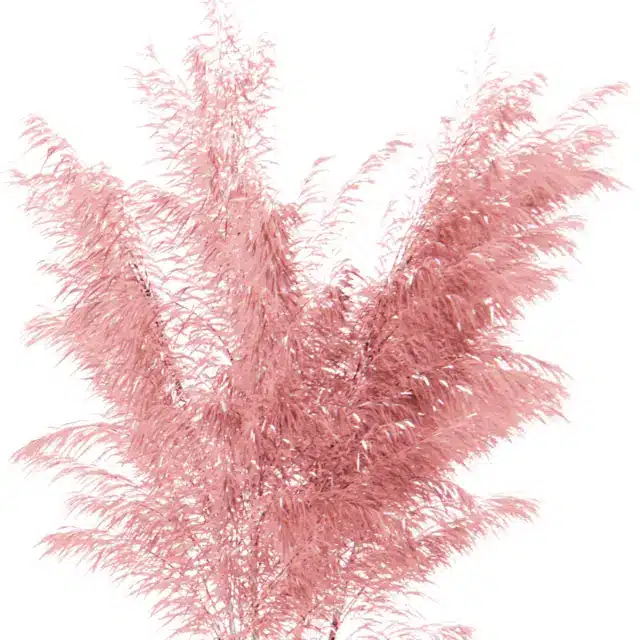
Muhlenbergia capillaris grows to about 3 to 4 feet tall and 2 to 3 feet wide. It forms a dense clump, making it a good choice for mass plantings or as a focal point. It’s also suitable for smaller gardens or containers.
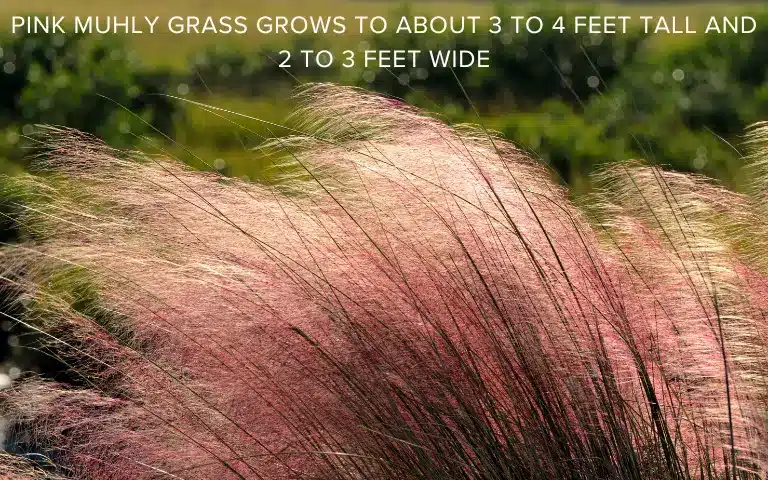
Grow Muhlenbergia capillaris in Ideal Conditions
Muhlenbergia capillaris needs the right conditions to grow and bloom:
Best time to plant pink muhly grass ⌛
Plant Muhlenbergia capillaris in spring or fall when it’s mild and there’s enough moisture in the soil. Spring planting lets the grass get established before the summer heat, while fall planting lets it get established before winter.
Sunlight 🌞
This grass thrives in full sun, so it’s important to choose a spot in your garden that receives at least 6 to 8 hours of direct sunlight each day. Without adequate sun exposure, the grass may not flower as profusely or may become leggy.
Soil 🌱
Pink Muhly Grass likes soil that drains well. It can grow in many types of soil, but not in clay. It likes soil that is slightly acidic to neutral, with a pH between 6.0 and 7.5.
Water requirements 💧
Pink Muhly Grass is drought-tolerant once established, but needs regular watering during its first few weeks. Water deeply and let the soil dry out between waterings. Once the grass is established, it can handle droughts, but it may need more water during dry spells.
When Pink Muhly Grass Blooms
Muhlenbergia capillaris blooms in late summer, usually around August or September. Its pink flowers continue to grace the garden throughout the fall season, providing color when most other plants are fading.
The blooming period may vary, but you can expect Muhlenbergia capillaris to bloom for several weeks. The flowers gradually fade to a tan or beige color, but they still look good.
The blooming period of Muhlenbergia capillaris adds a sense of excitement and anticipation to the garden. As summer transitions to fall, the vibrant pink blooms create a visual spectacle, attracting attention from both humans and pollinators. The delicate movement of the flowers in the breeze adds an extra element of enchantment to the garden landscape.
Locations Where Pink Muhly Grass Thrives: What Zone is Pink Muhly Grass
If you’re looking for a place where Muhlenbergia capillaris thrives, look no further!
Pink Muhly Grass is native to the southeastern United States, where it thrives in the warm and humid climate. It is commonly found in states such as Texas, Florida, Louisiana, and South Carolina. However, Pink Muhly Grass can also be grown successfully in other regions with similar growing conditions.
If you live in a region with hot summers and mild winters, Muhlenbergia capillaris is an excellent choice for your garden. It can tolerate temperatures as high as 100°F (38°C) and is hardy in USDA zones 6 to 10. However, it may struggle in areas with severe winter cold or prolonged freezing temperatures.
In terms of soil, Muhlenbergia capillaris is adaptable and can grow in a variety of soil types as long as they are well-drained. Sandy or loamy soil is ideal, but the grass can also tolerate clay soil as long as it doesn’t retain excessive moisture. If you have heavy clay soil, consider amending it with organic matter to improve drainage before planting Pink Muhly Grass.
Pink Muhly Grass looks great in any garden, big or small. Its pink blooms bring color to any location. Plant it as a border, in mass plantings, or in containers.
How to Plant Pink Muhly Grass
Planting pink muhly grass is easy, but a few steps can help it grow well. Here’s how to plant pink muhly grass in your garden:
- Choose the right location: Select a spot in your garden that receives full sun for at least 6 to 8 hours a day. Ensure the soil is well-drained and avoid areas prone to waterlogging.
- Prepare the soil: Before planting, prepare the soil by removing any weeds or grass and loosening it with a garden fork or tiller. Incorporate organic matter, such as compost or well-rotted manure, into the soil to improve its fertility and drainage.
- Dig the planting hole: Dig a hole that is slightly wider and deeper than the root ball of the Pink Muhly Grass. This will allow the roots to spread out comfortably.
- Plant the grass: Place the Pink Muhly Grass in the hole, ensuring that the top of the root ball is level with the surrounding soil. Backfill the hole with soil, gently firming it around the roots to eliminate air pockets.
- Water thoroughly: After planting, water the Pink Muhly Grass deeply to settle the soil and provide moisture to the roots. Keep the soil consistently moist but not waterlogged during the initial growth period.
- Mulch the area: Apply a layer of organic mulch, such as wood chips or straw, around the base of the grass. This will help conserve moisture, suppress weeds, and insulate the roots during extreme temperatures.
- Provide ongoing care: Regularly water the Pink Muhly Grass during dry spells, especially in the first year. Once established, the grass is relatively low-maintenance, but it may benefit from occasional fertilization and light pruning to maintain its shape.
How long does pink muhly grass take to grow
Is not a fast-growing grass. It grows slowly, Muhlenbergia capillaris takes about 1-2 years to reach maturity. However, this can vary depending on the conditions, climate, and care. But produces beautiful pink plumes in the fall.
Pink muhly grass in a pot
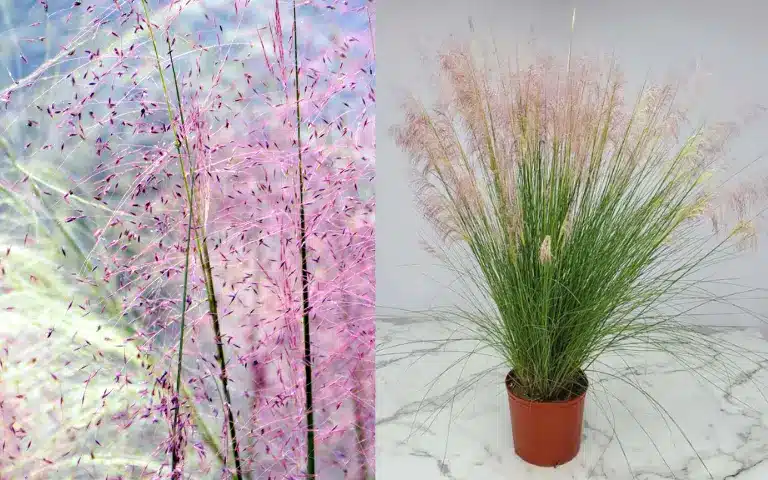
This ornamental grass can be grown in a pot, making it a great option for those with limited garden space. Here are some tips for growing PM Grass in a pot:
- Choose a pot at least 12 inches in diameter with drainage holes to prevent waterlogging.
- Use a potting mix with lots of organic matter. Pink Muhly Grass likes slightly acidic soil with a pH between 6.0 and 6.5.
- Plant your grass in the pot. Leave space around the plant for it to grow.
- Water your PM Grass well after planting and then let the soil dry out a bit before watering again.
- Put your pot in a sunny spot.
What to plant with pink muhly grass
Muhlenbergia capillaris looks good with other plants. Here are a few ideas:
Ornamental grasses:
Other ornamental grasses like fountain grass (Pennisetum), switchgrass (Panicum), or little bluestem (Schizachyrium) can be used with pink muhly grass to create a natural look.
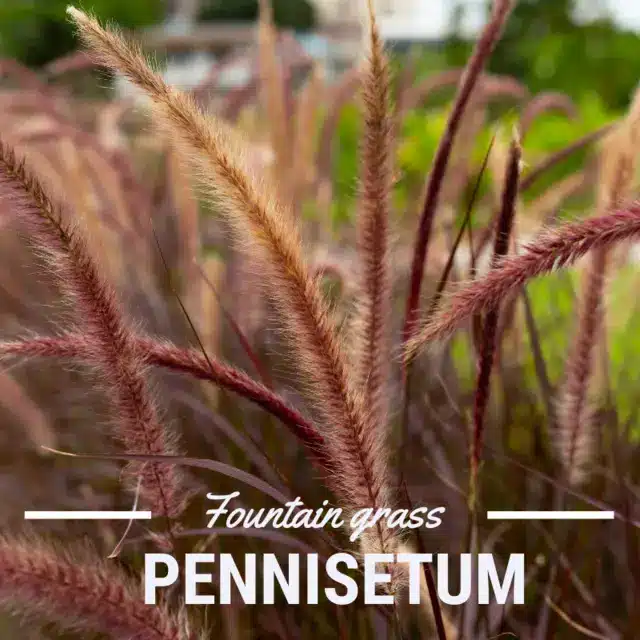
Perennials:
Plant perennials like coneflowers (Echinacea), black-eyed susans (Rudbeckia), or sedums to add color and texture to your garden.
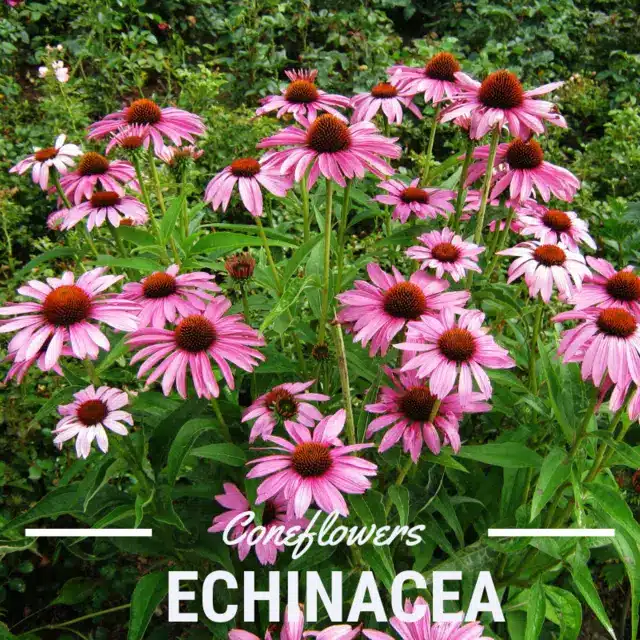
Shrubs:
Low-growing shrubs like dwarf butterfly bush (Buddleia), dwarf spirea (Spiraea), or dwarf burning bush (Euonymus) can add structure and contrast to the grass.
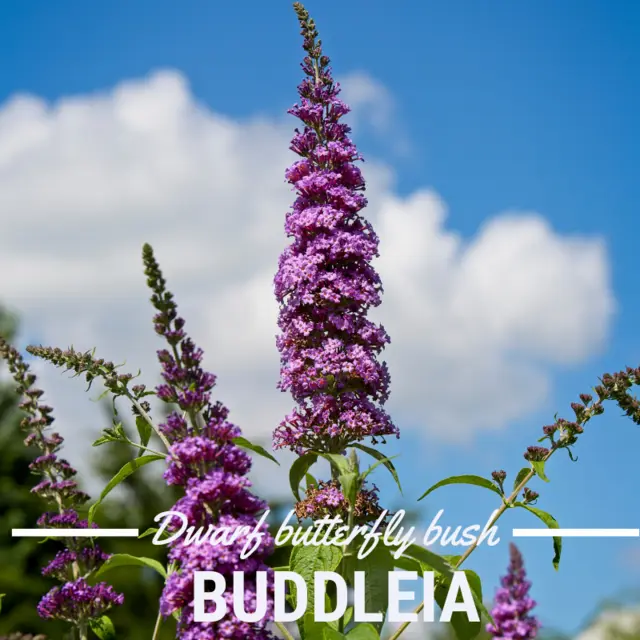
Groundcovers:
Planting groundcovers like creeping phlox (Phlox subulata), creeping thyme (Thymus serpyllum), or creeping juniper (Juniperus horizontalis) can fill in gaps and add interest to the landscape.
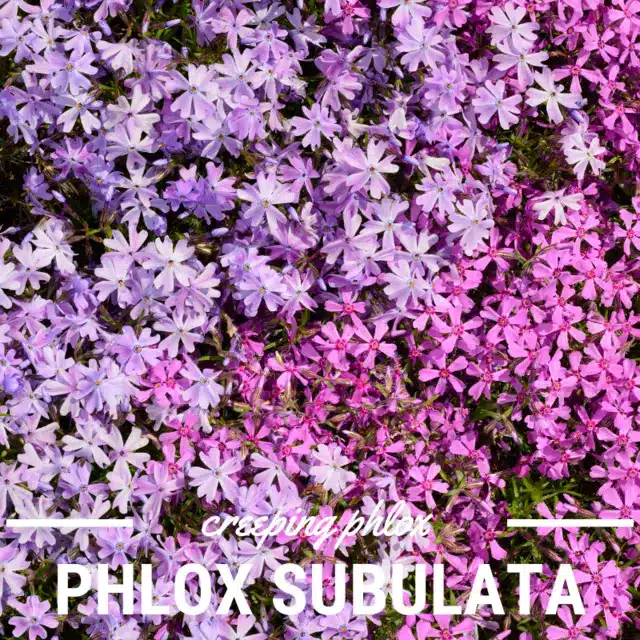
How to Maintain Pink Muhly Grass (Caring for Pink Muhly Grass)
Muhlenbergia capillaris is easy to take care of once it’s established. It still needs care to stay healthy and live long. Here are some tips for caring for pink muhly grass:
Pink muhly grass winter care
As winter approaches, take care of your PMGrass to make it grow in spring. Here are some tips for winter care:
- Cut back your pink muhly grass before the first frost. This helps maintain its shape and encourages new growth in the spring. Cut the grass back to about 6-8 inches with a pair of sharp garden shears.
- Add mulch around the base of the grass after pruning. This will help the roots stay warm. Use organic mulch like straw, leaves, or wood chips.
Watering
PM Grass is drought-tolerant, but it still needs water during dry periods. Water deeply, but let the soil dry out a bit between waterings. Don’t overwater, or it will rot.
Fertilize
PM Grass doesn’t need regular fertilizing because it can grow in poor soil. A light application of fertilizer in early spring can help it grow and bloom.
Dividing
PM Grass may become overcrowded and form dense clumps over time. If the grass is weak or doesn’t flower, it may need dividing. Dividing pink muhly grass every few years makes the plant stronger and lets you share new plants with others.
When to cut pink muhly grass
PM Grass doesn’t need a lot of pruning, but you can help it stay looking good by cutting back any dead or damaged parts in late winter or early spring. Don’t cut it too much, though, as this can reduce its blooming potential.
How to Harvest Pink Muhly Grass Seeds
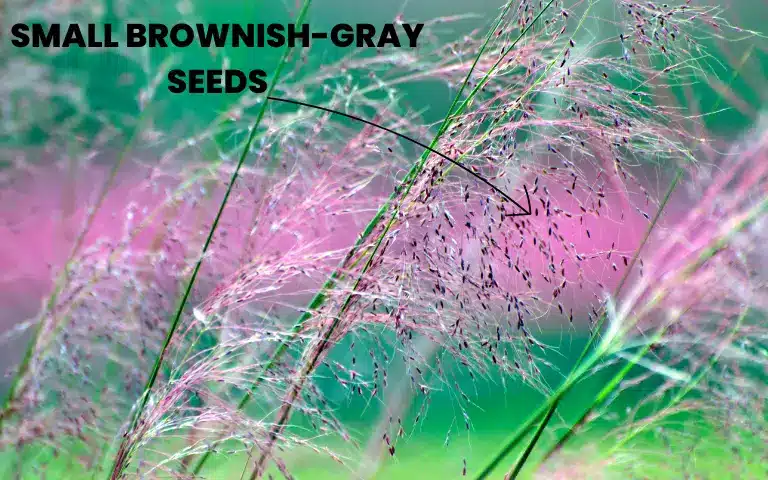
Harvest seeds from PM Grass in late fall or early winter. Here are the steps:
- Look for seed heads on your PM Grass. They are at the top of the plant and are made of small brownish-gray seeds.
- Harvest only mature seeds. Mature seeds are brown and dry. They should easily detach from the seed head when you rub them between your fingers.
- Once the seeds are mature, you can harvest them. Cut the seed heads off the plant with your hands or garden shears. Don’t damage the plant or seeds.
- After harvesting, spread the seed heads on a clean, dry surface to dry. This takes a few days to a week, depending on humidity and temperature.
- Once the seed heads are dry, you can separate the seeds from the chaff. Gently rub the seed heads between your hands or use a sieve.
- Store the seeds in a cool, dry place. Use a paper envelope or a plastic bag with holes for ventilation. Label the container with the date and type of seeds.
Common Problems and Pests for Pink Muhly Grass
PM Grass is resistant to pests and diseases, but can still have issues. Here are a few common problems:
- Fungal diseases: PM Grass can get fungal diseases like rust or leaf spot. These diseases are often caused by too much moisture or poor air circulation. To prevent fungal issues, don’t water overhead, give plants space, and let the garden breathe.
- Root rot: Overwatering or poor drainage can cause root rot in PM Grass. This can make the roots weak or die, which makes the plant grow poorly or die. To prevent root rot, plant Pink Muhly Grass in well-drained soil and water sparingly.
- Pests: PM Grass is resistant to pests, but it can attract grasshoppers or spider mites. These pests can damage the leaves by eating them or sucking the plant’s sap. Monitoring and quick action can help keep pests under control.
Pink Muhly Grass Landscaping Ideas
PM Grass can enhance your landscape and create stunning displays. Here are some ideas for using pink muhly grass in landscaping:
Border or Edging Plant: Plant PM Grass along the edges of flower beds or pathways to create a soft and colorful border. The vibrant pink blooms will contrast beautifully against green foliage or other plants, adding a touch of elegance and visual interest.
Mass Planting: Create a dramatic impact by mass planting PM Grass in a large area. The dense clumps of grass with their pink plume-like flowers will create a sea of color and movement, making a bold statement in your garden.
Natural Privacy Screen: Use PM Grass to create a natural privacy screen or to hide unsightly elements in your garden. Plant it in a row or staggered pattern to form a living wall that offers both beauty and privacy.
Container Planting: PM Grass can also be grown in containers, making it a versatile choice for small gardens, balconies, or patios. Select a large container with adequate drainage holes and fill it with well-drained potting mix. Plant the grass in the container, and place it in a sunny spot to enjoy its stunning blooms up close.
Cut Flower Arrangements: The beautiful pink plumes of PM Grass make excellent cut flowers for floral arrangements. Harvest the blooms when they are fully open and use them to create eye-catching bouquets or add a unique touch to flower arrangements.
PM Grass can be used in many landscaping projects to make your garden more beautiful. Try different planting schemes and combinations to create a unique landscape.
Conclusion and Final Thoughts
Pink Muhly Grass is a gorgeous plant with beautiful pink flowers, a graceful movement, and easy maintenance. Its fine, airy foliage and show-stopping flowers make it a standout ornamental grass. Pink Muhly Grass is a great choice for flower beds, privacy screens, and landscapes.
Pink Muhly Grass is a real beauty! It needs full sun, well-drained soil, and occasional watering to grow and bloom. With a little care, this grass will reward you with pink plumes in late summer and fall.
Why wait? Bring the beauty of pink muhly grass to your garden and enjoy its blooms for years.
Frequently Asked Questions
How long does pink muhly grass bloom
PM Grass blooms from September to November. The blooming period depends on the climate and growing conditions.
The grass stays green all winter.
Can I grow pink muhly grass in containers?
You can grow PM Grass in containers. It won’t grow as big or produce as many plumes in a container. Make sure the container has good drainage.
Is pink muhly grass drought-resistant?
Yes, it’s drought-tolerant once it’s established. Water the plant regularly during the first growing season to help it establish a strong root system.
How tall does pink muhly grass grow?
PM Grass grows to 2-3 feet tall and 2-3 feet wide. The pink plumes can add another foot or so in height during the fall blooming season.

About the Author
With over a decade of hands-on experience in home garden care, I’ve cultivated a deep-rooted passion for nurturing indoor greenery.



